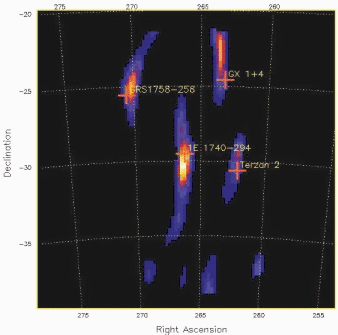| Active galaxies represent the largest class of gamma-ray
emitters. These sources are incredibly powerful but are also highly
variable.
Look once and it is there, look again and there is no emission. This
variability
is because of the physics of the region surrounding the gigantic black
hole presumed to power the active galactic nuclei. Emission from these
"Blazar" AGN are believed to come from the jets of relativistic particles
emanating out from "a central engine". Such jets are seen in radio maps
of these sources. Compton studies of active galaxies have been one
of the greatest successes of the mission. Over 60 Blazar-type AGN have
been detected by the EGRET instrument alone. |
A second type of AGN, known as Seyfert galaxies,
also comprises an important class of gamma-ray emitting AGN. About 17 of
these galaxies, which are much closer to the Milky Way than Blazars, have
been detected mainly by the OSSE instrument. In the theoretical unified
view of gamma-ray emission from active galaxies, Seyferts differ from
Blazars
in part because we are viewing them from a different angle, so that we
are looking through the galaxy rather than looking face on as in the
Blazars.
In this way, the jet emission is less important than emission more closely
associated with the inner regions of the galaxy itself. The OSSE instrument
has found that the average spectrum of the Seyfert galaxies is
well-described
by this sort of picture. |
Unexpectedly, the Seyfert spectrum
falls off much more quickly than previously thought. Previous observations
suggested that Seyfert emission extended up to the MeV range. The average
Seyfert spectrum indicates otherwise. This is an important clue to the
inner workings of AGN.
Accreting Galactic Sources Back in our own galaxy, the COMPTEL
source named GRO J0422+32 is a system known as a x-ray nova. This is an
example of a third type of gamma-ray source - studied mostly with OSSE
and BATSE - accreting galactic binary systems. The name describes the
system
well: a pair of stars, one normal and the other collapsed into a neutron
star or black hole, are in orbit around one another. There can be
relatively
steady emission of low-energy gamma rays, or episodic emission whenever
the pair are at their closest orbital approach. Studies of such objects
have been aided by the sensitivity and long mission of Compton. Another
example of these systems can be found by looking at the center of our own
galaxy. While not an imaging instrument in the classical sense, BATSE does
monitor the entire sky. As the Compton satellite orbits, sources are
alternately
hidden and revealed by the Earth. Techniques can be used to calculate a
coarse image of the sky using this information. The image of the galactic
center calculated using this technique shows that these low-energy
gamma-ray
emitters are numerous. |
